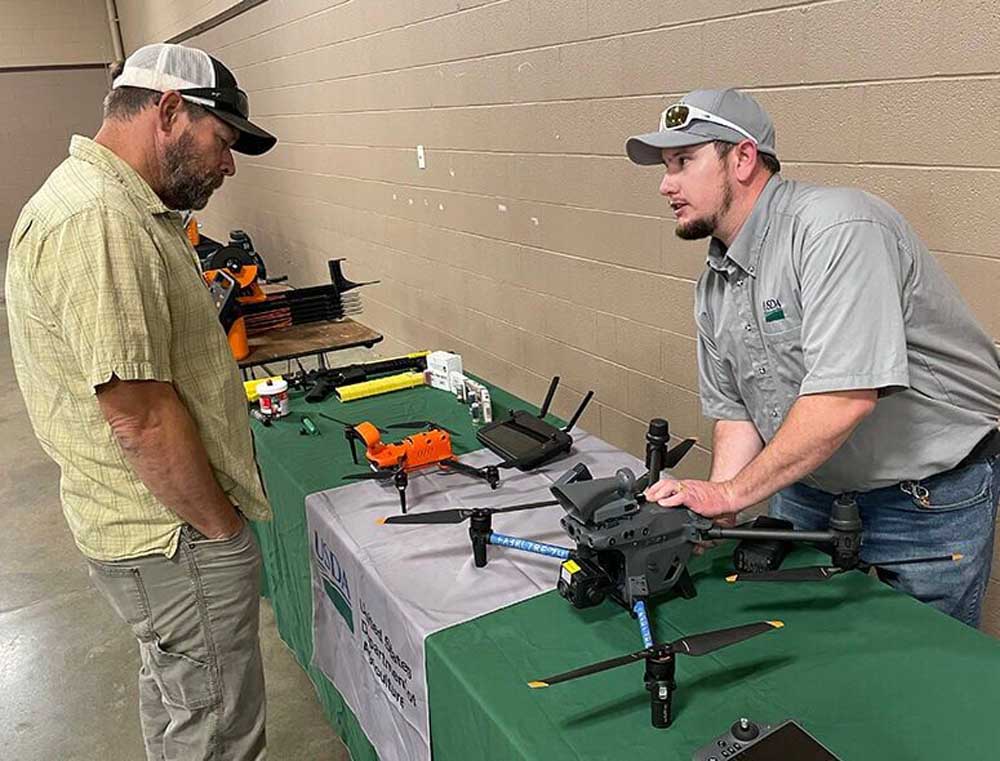Wildlife Services will investigate wolf attacks in Oregon
Published 6:15 am Monday, August 28, 2023

- Colby McAdams, right, a biological science technician specializing in wildlife for USDA Wildlife Services, speaks with Eric Evans, a natural resources manager based in Deschutes County, about how drones can be used to haze wolves from livestock during a workshop Aug. 23 in Klamath Falls.
KLAMATH FALLS, Ore. — USDA Wildlife Services will soon be allowed to investigate potential cases of wolf-livestock depredation in Oregon.
Trending
Paul Wolf, the agency’s district supervisor for southwest Oregon, said he is close to reaching an agreement with the state Department of Fish and Wildlife that would authorize Wildlife Services to assist with investigations where ranchers suspect a wolf has attacked livestock.
The announcement came during a workshop Aug. 23 at the Klamath County Event Center focused on reducing conflicts between ranchers and wolves.
Oregon ranchers have long been frustrated by the state’s process and criteria for confirming whether a cow or sheep was killed by wolves. By the time a biologist arrives to investigate, it is often too late to determine how the animal died, producers argue.
Trending
Wolf attacks must be confirmed by ODFW for ranchers to receive compensation, or to meet the minimum threshold for shooting wolves that habitually prey on livestock — defined as “chronic depredation.”
Only wolves in Eastern Oregon qualify for lethal management. The species remains federally listed as endangered west of highways 395, 78 and 95.
Wolf said producers have been pushing for Wildlife Services to carry out investigations for a long time, allowing them to pivot more quickly to lethal management or adopt non-lethal deterrents to avoid further losses.
“We’re going to be able to make those calls on the ground,” he said.
Endangered species
About 80 people attended the two-day workshop sponsored by Wildlife Services and the Western Landowners Alliance, including ranchers from parts of central and southwest Oregon, where wolves are spreading.
Sam Dodenhoff, a local wildlife biologist for ODFW, said there was a minimum count of 178 wolves statewide at the end of 2022. Of those, 22% now reside in the Western Management Zone, which includes Klamath and Jackson counties.
Last year was also the first time ODFW documented at least four breeding pairs of wolves in Western Oregon. If that conservation objective is met again in 2023 and 2024, the region will move into Phase II of the state’s wolf management plan.
The Trump administration temporarily delisted wolves across the Lower 48 in 2020, though that decision was overturned by a federal judge in 2022 after environmental groups sued.
Wolves are still delisted in the northern Rocky Mountains, including Montana, Wyoming, Idaho and parts of eastern Oregon and Washington.
For Western Oregon ranchers, however, lethal management remains off the table. They are limited to using non-lethal tools, such as range riders, fladry, guard dogs, drones, flashing lights and alarm boxes to haze wolves from livestock.
Elizabeth Willy, wolf coordinator for the U.S. Fish and Wildlife Service’s Pacific Southwest Region, said her agency plans to complete a status review and proposed rule regarding wolf conservation in the Lower 48 by February 2024.
Ranchers speak out
For now, Willy said officials need to “focus on long-term conservation of the gray wolf as part of long-lasting, sustainable recovery.”
But ranchers say their patience is wearing thin.
Veril Nelson, a Douglas County rancher and wolf committee co-chairman for the Oregon Cattlemen’s Association, said the group was successful in securing $1 million from the state Legislature to compensate ranchers for livestock killed by wolves.
Still, Nelson said that is not enough.
OCA had pushed for ranchers to be paid out at a 7-to-1 ratio for each animal killed. Nelson said this would cover the cost of implementing non-lethal measures as well as indirect production losses such as reduced weight and calving rates and loss of pasture due to wolves.
“All of the burden of these wolves is on ranchers,” Nelson said. “We need to move to more proactive management, rather than staying in this conservation mode.”
Diana Wirth, a Klamath County rancher and past president of the Oregon CattleWomen, said wolf sightings and conflict are becoming more common for producers in the area, which has heightened the need for action.
“Until our rights as property owners to defend ourselves and our families are restored, all you’re going to be doing is running around chasing your tail on these issues,” she said.









